Abstract
Although chert deposits are limited in geological distribution, their geological and geochemical characteristics can provide important information to reconstruct paleoenvironmental and diagenetic processes. For the Permian period, cherts are utilized to trace global silicon cycles and hydrothermal activities in relation to the Permian Chert Event. In Northwest China, Permian chert nodules have recently been discovered in both the southeastern and northwestern margins of the Junggar Basin. We conducted an analysis of the mineralogy, petrology and geochemistry of chert nodules of the Lucaogou Formation in the southeastern margin of the Junggar Basin to identify silicon sources and determine the precipitation mechanism of chert nodules. As evidenced by petrology, the chert nodules were mainly composed of crypto-microcrystalline silica (94.33% on average), with development of a soft-sediment deformation structure, indicating the synsedimentary deposition of silicon. Proven by trace elements, high Eu/Eu* ratios (average 2.14), low total rare earth element content (average 6.03 ppm), low LaN/YbN ratios (average 0.17) and low Y/Ho ratios (average 25.25) in chert nodules supports the hydrothermal source of silicon. The wide distribution of authigenic metal-bearing minerals and the significant positive Eu anomalies observed suggest that the chert depositions in the Lucaogou Formation intermittently received high-temperature (>250 °C) hydrothermal fluids, likely associated with the initiation of the Bogda Rift in the middle Permian. Following rapid cooling down and differential compaction, siliceous sediments dehydrated and deformed, finally forming chert nodules.
1. Introduction
Cherts are limited in distribution; however, these deposits are resistant to diagenetic alteration and, thus, serve as important archives of sedimentary environmental [1,2,3] and diagenetic processes [4,5]. Continental silica is a major source of both marine and lacustrine chert deposits [6] as a consequence of chemical weathering from continental siliciclastics [7]. Hydrothermal solutions, carrying silicon-rich fluids, can promote the regional precipitation of chert deposits [8]. Cherts are normally characterized as bedded and nodular distributions. Bedded cherts are mostly associated with inorganic and/or biogenically induced precipitation [9], while nodular cherts result from complex interactions between depositional processes [10,11] and diagenetic alternations [4,12,13]. Subsequent alteration by diagenetic metasomatism and filling processes in the voids further hinders the interpretation of cherts [4,14]. Therefore, sedimentary structures of chert nodules are essential to elucidate the depositional process. Trace elements in cherts are indicative of the main determinants of chert nodule formation, such as biological interference [15], hydrothermal activity [16] and the alkalinity of water [17,18].
Chert deposits in geological records trace silicon cycles and, thus, provide a record of the regional paleoenvironment and diagenetic processes [19,20,21]. Some significantly enriched chert deposits have been associated with global geological events [22,23]. For instance, the Permian Chert Event (PCE) is globally documented in coastal, island arc and oceanic basins [2,12,24] and is related to the periodic silicification of oceans [22,25] and the efficient scavenging of silica-secreting organisms [2,26]. Therefore, Permian cherts are crucial records of marine/lacustrine conditions and hydrothermal activity [12,22]. In China, the Permian chert deposits resulting from the PCE are mainly preserved in southern basins [12,19,22]. These Permian cherts are mostly associated with deep-source fluid activity [19,25] and flourishing siliceous organisms, corresponding to oceanic evolution and upwelling currents, respectively [3,27]. Recently, Permian chert deposits have been reported in lacustrine settings in the Junggar Basin, NW China, including the Fengcheng Formation in the NW Junggar Basin [28] and the Lucaogou Formation (LCG Fm.) in the SE Junggar Basin [29]. Detailed petrological and geochemical analyses were conducted in the Fengcheng Formation, indicating that the main controls included hydrothermal fluid activity, microorganism induction, and the condition of alkaline lake water [28,30,31]. Research on cherts in the LCG Fm. is relatively limited. Determining the origin of LCG cherts is essential for tracing hydrothermal activity [4,32], determining organic matter enrichment mechanisms [33,34] and reconstructing reservoir evolution [35,36,37].
Here, we report sedimentological and geochemical analyses undertaken on chert nodules from the LCG Fm. to determine their depositional mechanisms and the silicon source of Permian cherts in the SE Junggar Basin.
2. Geological Background
The Junggar Basin, NW China, is bounded by the Tianshan Mountains to the south, the Altai Mountains–Kelameili Mountains to the northeast, and the Zaire Mountains to the west. The Bogda Mountain, located in the north Tianshan (NTS), SE Junggar Basin (Figure 1a), is the southern segment of the central Asian orogenic belt, serving as a pivotal tectonic belt separating the Turpan–Hami Basin and the Junggar Basin [38,39]. In the Permian, however, the Junggar Basin was located at the SE Kazakhstan Plate of Pangea (Figure 1b), which migrated northward from ~30 °N to 50 °N [40,41]. Accordingly, the Bogda Mountain is deemed to be located in the greater Turfan–Junggar rift basin [42,43], as the product of the southward subduction of NTS oceanic crust during the late Paleozoic [44,45,46]. The XLK1 well, which was investigated in this study, is a cored well located at the Xiaolongkou profile in the northern Bogda Mountain (Figure 1a). The core diameter of the XLK1 well is 10 cm and the well depth is 4900 m.
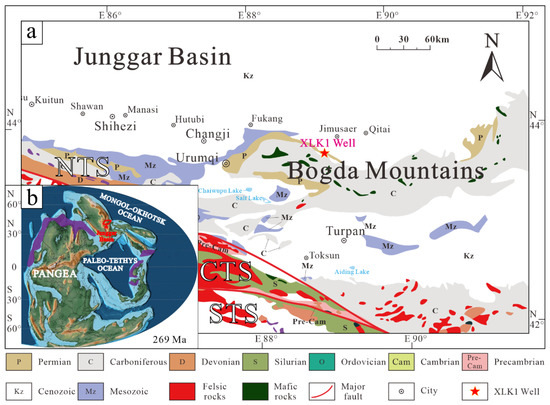
Figure 1.
(a) Tectonic map of Bogda Mountain showing the location of XLK1 well (red star; adapted from Wang et al., 2018 [47]), NTS = North Tianshan, CTS = Central Tianshan, STS = South Tianshan; (b) Guadalupian–Lopingian global paleogeography (adapted from Scotese and Schettino, 2017 [48]), the location of Junggar Basin (circled by red line); the purple covered area shows the main distribution of Permian cherts reported to date [12,24,26].
The Bogda area experienced three main stages of tectonic and sedimentary evolution: (1) Late Carboniferous–middle Permian: the major extensional period with the formation of the Bogda intra-continental rift basin [49,50]. The environment evolved from shallow marine to lacustrine [51]; (2) Late Permian–early Triassic: the Bogda area is still an extensional basin [38,39], which mainly developed as delta or lacustrine environments [47]; (3) Triassic–Cretaceous: the Bogda Mountain uplifts, caused by the Indosinian movement, leading to separation of the Junggar Basin and the Turpan–Hami Basin [52]. Although the current Bogda Mountain has an average elevation of 4000 m [38], it was interpreted as a rift basin with low elevations and frequent intermittent hydrothermal activity during the middle Permian [33,34].
The LCG Fm., with a thickness of ~200–1000 m [53,54,55] was mainly deposited in the SE Junggar Basin in the Great Turpan-Junggar rift basin (Figure 1a) [56,57]. The age of the LCG Fm. is tentatively suggested to be 268–270 Ma [53,58]. The LCG Fm. is one of the primary source rocks and shale oil reservoirs in the Junggar Basin [59,60], normally occurring as black shales, siltstones and marlstones, with a small number of nodular cherts occurring in the marlstones (Figure 2) [29,61]. Accordingly, the LCG Fm. is understood to be a deep (probably exceeding 100 m in depth), brackish and stratified lacustrine environment [62,63,64], with an estimated paleo-temperature of about 3–25 °C [65]. The dense black shale deposits in the LCG Fm. indicate strong reducing conditions [66,67] with high productivity [34]. Intermittent hydrothermal activities were identified in the surrounding area, as evidenced by high proportions of plagioclase and dolomitic rock, which are similar to typical hydrothermal sedimentary rocks [34], abnormally high concentrations of Sr and Li [29,68], and the development of hydrothermal analcite and dolomite [33,69,70].

Figure 2.
The Permian age framework of the southeastern Junggar Basin [53], the XLK1 well lithology column and the position of samples. Chert nodules are circled by yellow dotted lines.
3. Methods
3.1. Sample Pre-Treatment
To prevent potential chemical weathering of rock samples from outcrops, drill-core samples were targeted and collected for chert analysis. A total of 25 samples were selected from the XLK1 well, which was drilled in the north of Bogda Mountain (Figure 2). Selected samples included chert nodules (n = 18) and surrounding rocks (n = 7). In chert nodule samples, thick polished slabs, large thin sections made from the counterpart slabs, and region-specific plates with ~1 cm2 fresh surfaces were prepared for sedimentary, petrologic and scanning electron microscope (SEM) analysis, respectively. To avoid the cracks in chert nodules, powders of cherts were drilled by a micro-drill fixed with a 1.5 mm-diameter needle (Figure 3). About 1 g powder of each chert sample was collected. For the surrounding rock samples, powders were ground to a 200-mesh size using a vibrating ball-mill. All the powder samples were then prepared for further analysis, including X-ray diffraction (XRD) and elemental geochemistry assessments.
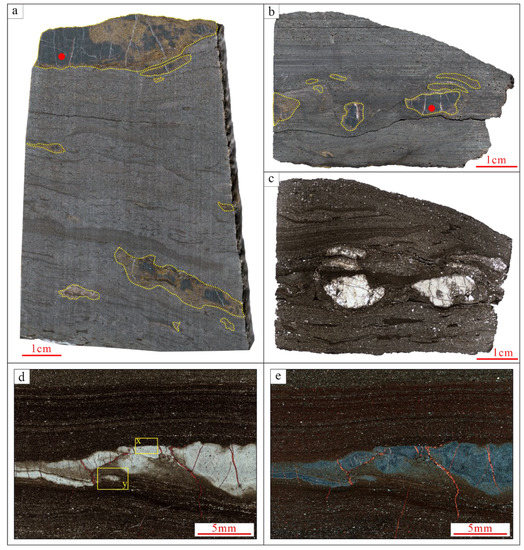
Figure 3.
Photographs and optical photomicrographs of chert nodules in the Lucaogou Formation from the Junggar Basin, NW China. Chert nodules are circled by yellow dotted lines in (a,b). (a) Fresh surface of sample cut by diamond wire saw; the position of sample C-01 is shown in the red dot; (b) fresh flat surface of sample cut by diamond wire saw; the position of sample C-07 is shown in the red dot; (c) plane-polarized photograph of chert nodule; (d) plane-polarized photograph of chert nodule; (e) cross-polarized photograph corresponding to (d).
3.2. Petrological Observation and Mineral Analysis
A total of 25 large thin sections was produced for petrological analysis. Half of the area of the thin sections was dyed with alizarin red stains to distinguish carbonate minerals. Petrological observations were conducted under cathodoluminescence, plane-polarized light (PPL) and cross-polarized light (XPL). Petrological structures and elemental distributions were examined using a Bruker Tornado M4 micro-X-ray fluorescence analyzer (Micro-XRF, Bruker, Billerica, MA, USA). Two-dimensional elemental mapping was conducted on three selected thin sections. The scanning for mapping was set with a spatial resolution of 30 μm/point and the measuring duration of each point was 7 ms.
Based on the petrological analysis, the microscale signatures and mineral composition of the chert nodules were analyzed by SEM and subsequently XRD analysis following the protocol in Ma et al., 2017 [71]. Briefly, the ~1 cm2 plates with multidirectional fresh surfaces were fixed and observed on a field emission-environment scanning electron microscope in backscattered electron (BSE) and secondary electron (SE) modes. The SEM analysis was carried out on an FEI Quanta 650 FEG at the MOE Key Laboratory of Orogenic Belts and Crustal Evolution, Peking University, China. The mineral composition of 18 selected chert powdered samples was measured using a D/max-rA rotating anode X-ray diffractometer (PANalytical; 40 kV, 12 kW) at the College of Chemistry and Molecular Engineering, Peking University, China. About 1 g of powder of each chert sample was weighed, flattened and compressed on a glass slide and then tested. The samples were continuously scanned for 6 min under a 2θ angle ranging from 5° to 60°. The mineral proportions were semi-quantitatively calculated using the General Structure Analysis System program [72].
3.3. Major and Trace Elemental Analysis
The dissolution of rock samples was undertaken using the sequential acid-leaching method [4,14]. Specifically, about 100 mg each of powdered samples of chert nodules were weighed and washed three times (for about 5 min each time) in 3 N HCl to remove carbonate fractions. After washing three times by Milli-Q water and centrifuging, the insoluble residuals were then evaporated in a drying cabinet at 65 °C. The surrounding rock samples were heated at 1000 °C for 2 h to determine loss on ignition (LOI). Subsequently, approximately 50 mg samples of surrounding rock and carbonate-free chert were weighed in Teflon beakers for digestion. A mixture of 3 mL concentrated HF (20.20 mol/L) and 1 mL concentrated HNO3 (14.76 mol/L) was added to the Teflon beakers and reacted on a 120 °C hotplate for 48 h. For complete digestion, the solution of samples was dried on the same hotplate, further dissolved in 3 mL concentrated HNO3 (14.76 mol/L) and then reacted on the 120 °C hotplate for a further 48 h. After complete digestion, sample solutions were again dried and dissolved in 2% HNO3 for elemental analysis.
The major elemental compositions were determined using an inductive coupled plasma optical emission spectrometer (ICP-OES), which was performed on a BLUE SOP at Peking University, while the trace element contents were measured by an inductive coupled plasma mass spectrometer (ICP-MS), which was performed on an iCAP RQ at Peking University. All major elements were calculated as oxides (i.e., Na2O, MgO, Al2O3, SiO2, K2O, CaO, Fe2O3, P2O5, TiO2). The silica content of the chert nodules was determined by subtracting the total weight of all other oxides following Shen et al., 2018 [4]. The silica content of the surrounding rocks was determined by subtracting the total weight of all other oxides and LOI. Replicate analyses yielded a relative 2σ reproducibility better than 10% and 5% for the ICP-OES and ICP-MS analyses, respectively.
4. Results
4.1. Petrology and Mineralogy
The chert nodules, with size-variations, are distributed in multiple layers upwards, and are mainly hosted in the marlstones of LCG Fm. (Figure 3). The morphology of the LCG chert nodules is various, including tabular, irregular elliptic, virgulate, and lenticular forms (Figure 3). The long dimensions of the chert nodules generally occur parallel to the layers and range from 2 to 60 mm. The short dimensions of the chert nodules vary from 1 to 40 mm, and occur perpendicular to the layers. The fresh surface of the nodular chert appears dark grey (Figure 3a,b). The soft-sediment deformation structures are well-developed in the chert nodules, forming consistent deformed characters with the surrounding rocks (Figure 4c,d). Under PPL, the sedimentation gradually alters from the surrounding rocks to the bottom of the chert nodules (Figure 3d and Figure 4b), while the boundary between the top of the chert nodules and the surroundings is distinct (Figure 4a). Quartz minerals, which form the chert nodules, occur as crypto-microcrystalline particles (Figure 4e), with no light emission under cathodic luminescence (Figure 4f). Under XPL, the quartz mineral exhibits crystal aggregation with sub-rectangular mosaic patterns (Figure 4e). In the exterior of each quartz particle, there are distinct radiating extinction bands (Figure 4e).

Figure 4.
Optical photomicrographs show textural and microscopic features of chert nodules in the middle Permian Lucaogou Formation from the Junggar Basin, NW China. Chert nodules are circled by yellow dotted lines in (a–d). (a) Chert nodule is in abrupt contact with the upper surrounding rock, enlarged image of area x circled in yellow in Figure 3d, PPL; (b) chert nodule intermingled with the bottom surrounding rock, enlarged image of area y circled in yellow in Figure 3d, PPL; (c) chert nodule showing soft sediment deformation, PPL; (d) soft sediment deformation occurs between chert and surrounding rock, XPL; (e) crypto-microcrystalline silica, radiating extinction band of one quartz crystal is circled by red dotted lines, XPL; (f) cathodoluminescence photograph corresponding to (e).
Compared with the surrounding rocks, the chert nodules are characterized by rich silicon content and low content of other elements (Figure 5b). The surrounding rock, with fewer chert nodules, is characterized by high Al content (Figure 5c) and low Mn content (Figure 5d). The abundance of nodules gradually increases stratigraphically downwards, along with decrease in Al content and increase in Mn content (Figure 5).
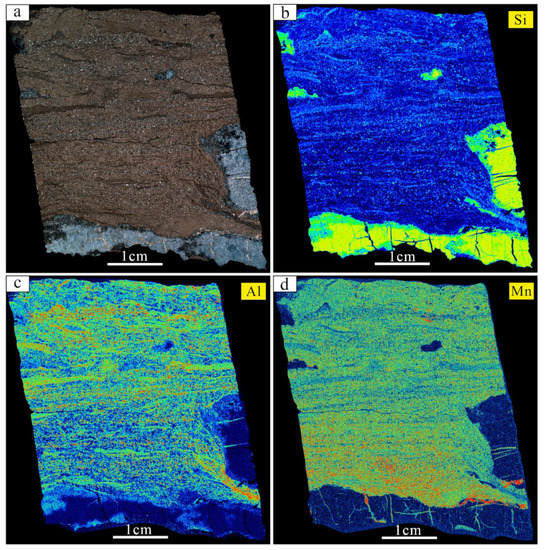
Figure 5.
Optical photomicrograph and Micro-XRF mapping images show elemental distribution of one representative large thin section from the Lucaogou Formation from the Junggar Basin, NW China. Elemental maps (false-color images) of Si-Kα, Al-Kα and Mn-Kα. (a) Chert nodules in surrounding rocks are unevenly distributed, XPL; (b) elemental map of Si; (c) elemental map of Al; (d) elemental map of Mn.
The XRD results show that the LCG chert nodules are mainly composed of quartz minerals with a low abundance of carbonate minerals, while the surrounding rocks are mainly composed of albite, quartz and calcite (Figure 6). The SEM results reveal the authigenic mineral characteristics of the LCG chert nodules. The quartz in the LCG chert nodules occurs mainly as euhedral crystal, but the size of the crystals, ranging from 1 to 20 μm, is small (Figure 7a,b). Authigenic metallic minerals, such as barite (BaSO4; Figure 7c), jacobsite (MnFe2O4; Figure 7d,e) and azurite (Cu2(CO3)2(OH)2; Figure 7f), with average particle sizes of 5 μm, 3 μm and 17 μm, respectively, are distributed in the chert nodules.
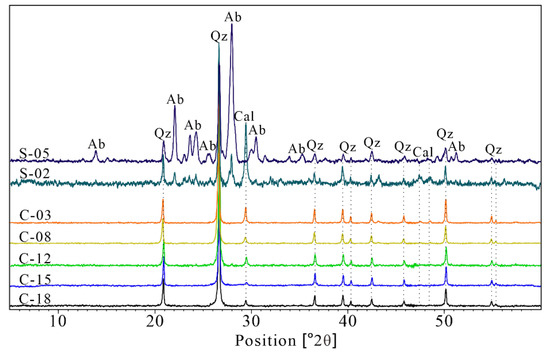
Figure 6.
XRD patterns of chert nodules and surrounding rocks in the Lucaogou Formation, Junggar Basin. Qz = quartz; Cal = calcite; Ab = albite.
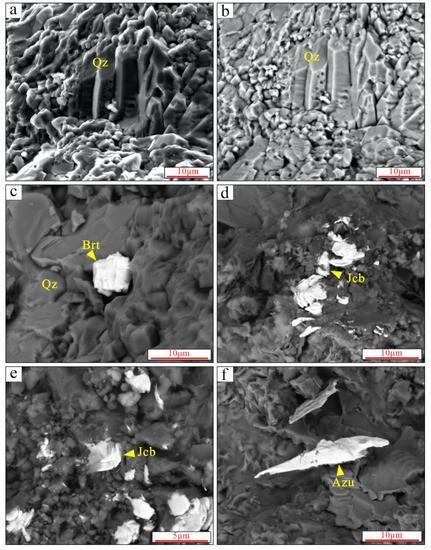
Figure 7.
Scanning electron microscope images of chert nodules in the Lucaogou Formation, Junggar Basin. (a) Quartz is crypto-microcrystalline with relatively poor crystallinity, SE image; (b) BSE image corresponding to (a); (c) authigenic barite in chert nodule, BSE image; (d,e) authigenic jacobsite in chert nodule, BSE image; (f) authigenic azurite in chert nodule, BSE image. Qz = quartz; Brt = barite; Jcb = jacobsite; Azu = azurite.
4.2. Elemental Compositions
4.2.1. Major and Trace Elements
The geochemical characteristics of the chert nodules in the LCG Fm. are similar to those of samples from the surrounding rocks (Table 1). Based on the major element composition, the chert nodules are mainly composed of SiO2 (94.33% on average), with minor components of MgO (2.16% on average), Al2O3 (1.74% on average) and Fe2O3 (1.11% on average), with other elements <1% in average content (e.g., Na2O, P2O5, K2O, CaO and TiO2; Table 1). Both the major and the trace elemental characteristics of the surrounding rocks are significantly different from the chert nodules in the LCG Formation. In the surrounding rocks, SiO2 remains the most abundant of all the major element oxides, ranging from 26.99% to 71.79% (50.90% on average). The content of other major element oxides, including Na2O (average 5.68%), MgO (average 2.94%), Al2O3 (average 13.85%), P2O5 (average 0.35%), K2O (average 1.93%), CaO (average 10.05%), TiO2 (average 0.41%) and Fe2O3 (average 2.78%) is generally higher than that in the chert nodules (Table 1). The content of trace elements in the surrounding rocks is significantly higher. For example, the average content of Mn and Ba in the surrounding rocks is 794 ppm and 562 ppm, respectively, while the content is 32 ppm and 57 ppm in the chert nodules, respectively (Table 1).

Table 1.
Major (wt%) and trace elements (ppm) of chert nodules and surrounding rocks in the Lucaogou Formation, Junggar Basin. The symbol “-“ indicates the unmeasured value.
4.2.2. Rare Earth Elements and Yttrium
The rare earth element (REE) concentrations, yttrium (Y) concentrations and associated parameters of the LCG chert nodules and surrounding rocks are summarized in Table 2. In the LCG Fm., the chert nodules display relatively low total REE content (∑REE; average 6.03 ppm), while the surrounding rocks are characterized by significantly higher ∑REE (average 146.89 ppm). We normalized the REE and Y concentrations of all samples according to Post-Archean-Australia-Shale (PAAS), as shown in Figure 8. The shale-normalized REE and Y concentrations of LCG chert nodules are characterized by moderate enrichment of heavy REE (HREE; LaN/YbN average 0.17), a prominent positive Eu anomaly (Eu/Eu* average 2.14) and a low Y/Ho ratio (average 25.25).

Table 2.
Rare earth elements (ppm) and yttrium (ppm) of chert nodules and surrounding rocks in the Lucaogou Formation, Junggar Basin.
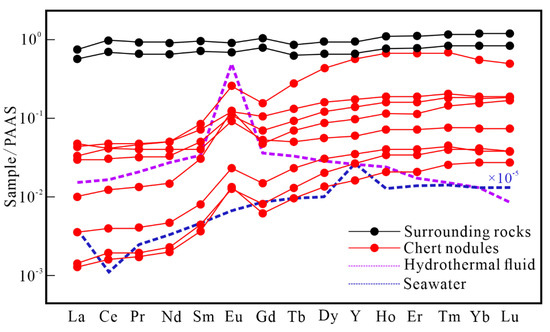
Figure 8.
Post−Archean−Australia−Shale (PAAS)−normalized rare earth element and yttrium values of chert nodules in the Lucaogou Formation, surrounding rocks in the Lucaogou Formation, hydrothermal fluid [73] and seawater [74].
5. Discussion
5.1. Origin of Chert Nodules
Although chert nodules in the LCG Fm. have various morphologies (Figure 3), the mineral and geochemical compositions of the chert nodules are similar, which is indicative of a consistent origin. According to the pathways of genetic mechanisms, cherts can be classified into three types: penecontemporaneous cherts, burial diagenetic cherts and meteoric diagenetic silcretes [11]. Penecontemporaneous chert is the product of dehydration in original siliceous sediments and provides clues for reconstruction of the sedimentary water conditions [3]. Diagenetic cherts, including burial diagenetic cherts and meteoric diagenetic silcretes, are normally formed by filling in of the voids or metasomatic carbonate/evaporite, mainly reflecting the pore fluid properties [4,14]. Here, in the LCG chert nodules, the silica mineral is mainly composed of crypto-microcrystalline particles, indicating the stage of very incipient crystallinity. Lacking metasomatic structure and the residual structure of the metasomatic surrounding rocks, the LCG chert nodules are barely affected by recrystallization and metasomatism processes. In addition, soft-sedimentary deformation (Figure 4c,d) and detachment structure (Figure 4c) are well-developed between the nodules and the surrounding rocks, occurring as penecontemporaneous cherts (e.g., Magadi-type cherts [75,76] and Coorong-type cherts [10]), further supporting the syndepositional origin of Permian chert nodules in the LCG Formation.
In some nodules, the boundary between the top of the chert nodule and the surrounding rock is distinct (Figure 4a), while the bottom of the nodule, with a blurred boundary, is mixed with the surroundings (Figure 4b). This feature is further indicative of the presence of unconsolidated surrounding rocks during chert deposition. Therefore, we speculate that the LCG chert nodules result from silicon-rich fluid activity at the water-sediment interface. When silicon-rich fluids touched the surroundings, the depositional process was interrupted, followed by the stirring up of unconsolidated lake bottom sediments, eventually forming a blurred bottom boundary (Figure 4b). After cessation of silicon-rich fluid activity, the sedimentary environment returned to normal and formed a clear top boundary of LCG cherts (Figure 4a).
Evidence obtained from SEM and Micro-XRF mapping also supports the importance of fluid activity in the formation of the chert deposits and provides preliminary clues for distinguishing the varied fluid properties. In the LCG Fm., barite (Figure 7c), jacobsite (Figure 7d,e) and azurite (Figure 7f), featuring as euhedral or semi-euhedral crystals (>3 μm, in general), are well distributed in the chert nodules. The formation of barite, manganese-bearing mineral, copper-bearing mineral and other metal-bearing minerals is associated with hydrothermal activities [77,78,79]. These source-specific minerals in the LCG cherts reveal their hydrothermal origins. The quartz crystals in the LCG chert nodules are closely packed with pores of small size (<2 μm in general; Figure 7b). The pore sizes are significantly lower than the crystalline sizes of authigenic metal-bearing minerals (Figure 7 c–f). Based on the syndepositional origin of the Permian chert nodules, these authigenic metallic minerals were formed simultaneously with the quartz minerals, indicating synchronous hydrothermal activity during chert precipitation.
Micro-XRF mapping shows changes in the elements and minerals (Figure 5). In LCG Fm., with decrease in the chert nodules upwards, the Mn content gradually decreases in the surrounding rocks (Figure 5d), while the Al content gradually increases (Figure 5c). Al and Ti are normally enriched in siliciclastics; therefore, they are effective indicators of terrigenous input [80,81]. The enrichment of Fe and Mn is also associated with hydrothermal deposits [1,3]. Here, the formation of LCG chert nodules is mostly related to hydrothermal activities, given high Mn content in the surrounding rocks with abundant chert nodules. We infer that the low Al content of the surrounding rock with abundant chert nodules may be a result of the dilution of terrigenous detritus by hydrothermal sediments; the Al content then gradually increases with the disappearance of dilution effects following hydrothermal activity.
5.2. Recognition of Silicon Sources during Chert Precipitation
The elemental compositions of cherts reflect their silicon sources [3,82,83]; however, evaluation of the geochemical data is essential before interpreting the geochemical data [12]. During ICP-MS measurement, some polyatomic ions, such as Ba, have similar masses to Eu, which may affect the Eu values obtained [84,85]. However, in LCG samples, the values of Ba essentially show no correlation with Eu, Sm and Gd (R2 = 0.01, 0.03 and 0.02 respectively), indicating valid element measurement. In addition, the values for REEs were evaluated assuming that REEs are difficult to fractionate during the diagenetic process [3]; however, they are easily affected by Fe- or Mn- oxides and terrestrial input [86,87]. The contents and patterns of ∑REEs (6.03 ppm on average) and other elements (e.g., Al2O3 1.74%, TiO2 0.06% on average) contrast with those in the surrounding rocks, reflecting their different mineral compositions and elemental systems. The content of Fe2O3 (1.11% on average) and MnO2 (32.02 ppm on average) is low in the chert samples. The lack of correlation between siderophile elements (e.g., Ni and Sc) and Y/Ho ratios further suggests that the cherts are not impacted by contamination by Fe- or Mn- oxides [86,87]. Moreover, the lack of correlation between TiO2 and ∑REE, Eu/Eu*, Ce/Ce*, and Y/Ho rule out a terrigenous source of ∑REEs in the cherts.
Enrichment of chert nodules in the LCG Fm. requires concentrated silicon. In general, continental silica provides most of the silicon in both marine and lacustrine contexts [6]. However, the element compositions of LCG chert, especially ∑REEs, contradicts this, assuming that the ∑REEs of continental silica show no negative Eu anomalies and flat patterns [2]. Siliceous organisms are deemed to be another consuming source of concentrated silica at a regional level. Although the solubility of silicon in modern seawater is low, abundant cherts can still be deposited, resulting from the efficient absorption of silicon by silica-secreting organisms, such as diatoms, radiolarians, and siliceous sponges [7,88]. However, there are no siliceous organisms reported in the LCG Fm. or fossilized organisms near these chert nodules, suggesting other silicon sources.
The temperature and pH of water are the key factors controlling the solubility of silica. However, the solubility of silica is little affected by pH when pH is less than 9 [11]. Moreover, there is no alkali lake reported in the LCG Fm. Therefore, in the LCG Fm., the temperature is the main factor controlling the solubility of silica. Hydrothermal fluids usually carry more dissolved silica due to greater solubility at higher temperatures [8]. For instance, hydrothermal fluids at 100 °C, 200 °C, and 300 °C are capable of dissolving 1 mM, 4.3 mM, and 11 mM of silica, respectively [4]. When siliceous high-temperature (HT) hydrothermal fluids penetrate and mix with cold water, the solubility of silicon can be reduced rapidly by 10–20 times, presenting a supersaturated state, leading to rapid precipitation of silica [11]. Here, according to the Al-Fe-Mn diagram [6], most of the LCG chert nodule samples are distributed in the hydrothermal area (Figure 9), which is consistent with the characteristics of Fe and Mn in hydrothermal silicon [6,89]. Thus, these chert nodules are mostly derived from a hydrothermal silicon source.
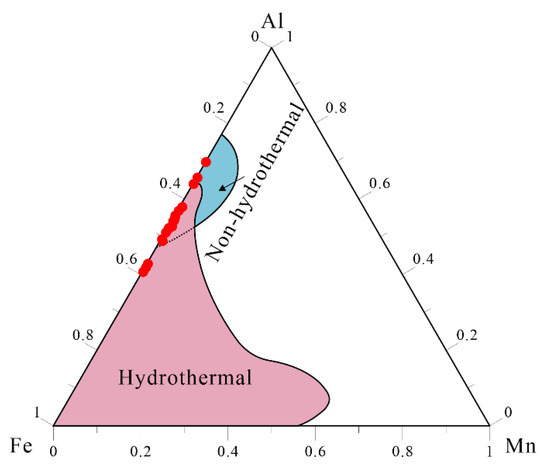
Figure 9.
Al-Fe-Mn ternary plot of chert nodules in the Lucaogou Formation. Hydrothermal and non-hydrothermal chert fields are from Yamamoto et al. (1987) [6].
Moreover, Y and REE, due to their similar properties [90], are often used together as indicators to identify the source of silica [22,91]. Some authors have reported the characteristics of hydrothermal cherts, including low ∑REE, relative enrichment of HREE [92], low Y/Ho (~27) [93] and particularly positive Eu anomaly values [4]. In the LCG Fm., the chert nodules are characterized by low ∑REE content (average 6.03 ppm), which is lower than that of typical hydrothermal cherts (such as the Permian cherts in the Ji Tingling [94] and the middle Permian cherts in the Qiangui basin [19]), relative enrichment of HREE (average LaN/YbN = 0.17), low Y/Ho ratio (average 25.25) and positive Eu anomalies (average Eu* = 2.14), displaying characteristics consistent with hydrothermal cherts [4,92,93], further supporting a hydrothermal silicon source. The PAAS-normalized REE + Y patterns of LCG chert nodules display features consistent with hydrothermal fluids [4,73] and features different from seawater [74,95], e.g., no negative Ce anomaly, no positive Y anomaly, and a significant positive Eu anomaly (Figure 8). Therefore, the primary silicon source of the LCG chert nodules is concluded to be hydrothermal fluid.
Since the positive Eu anomaly is a typical signature of hydrothermal origins, it has been regarded as an effective indicator for reconstructing hydrothermal temperature [4,22]. In the LCG Fm., the chert nodules show remarkably positive Eu anomalies (average Eu* = 2.14, up to 3.15), and display high-temperature (>250 °C) hydrothermal features [90,96], indicating input of large quantities of high-temperature (>250 °C) hydrothermal fluids. A significant positive Eu anomaly only occurs in a limited area within tens of kilometers of submarine volcanic or hydrothermal activity centers [19,97], as Eu can be fractionated from other REEs due to change in its valence state [12]. The valence state change from Eu3+ to more soluble Eu2+ which occurs under reducing and high-temperature conditions results in the enrichment of Eu in the sediments and the positive Eu anomaly observed [96,98]. As evidenced by the high Eu* content of the chert nodules, we infer that there were high-temperature (>250 °C) hydrothermal events near the Bogda area during the middle Permian.
5.3. Depositional Model of Permian Chert Nodules in LCG Formation
Based on the development of soft-sedimentary deformation, the presence of authigenic metallic minerals and a significant positive Eu anomaly, the hydrothermal origin of synsedimentary cherts is confirmed. Adding the sedimentary evidence, a depositional model of LCG chert modules is proposed. Temperature appears to be the key factor controlling the silica precipitation of LCG cherts, assuming their hydrothermal origin. The solubility of silica increases with elevated temperature [99]. Higher temperatures allow hydrothermal fluids to carry more silica for chert precipitation [8].
During the deposition of the LCG Fm., when Si-rich high-temperature hydrothermal fluids entered the deep lake, silica carried by hydrothermal fluids precipitated rapidly along with decreasing hydrothermal temperature and the presence of inchoate chert forms (Figure 10). This siliceous sedimentation contained significant amounts of water and is mainly displayed as banded or quasi-banded sediments (Figure 11a). Subsequently, differential compaction was the main factor leading to the morphologic differences in chert nodules. In early diagenesis, cherts were dehydrated due to the increasing pressure of the overlying strata and the morphologies of the cherts changed to nodular or lenticular accordingly (Figure 11b,c). Some cherts even penetrated the soft surrounding rocks and merged with adjacent cherts, forming larger chert nodules (Figure 11c). After the early diagenesis stage, chert nodules formed as a result of a consolidation process in the LCG Fm. in the Bogda area.
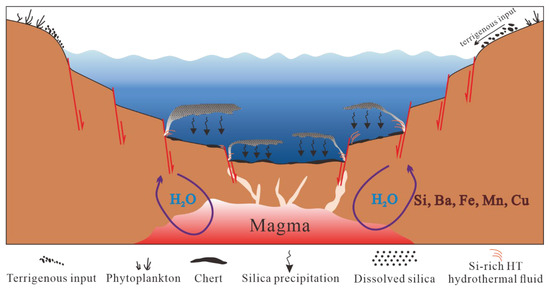
Figure 10.
Schematic diagrams showing the silica precipitation model of chert nodules in the Lucaogou Formation from the Junggar Basin, NW China.
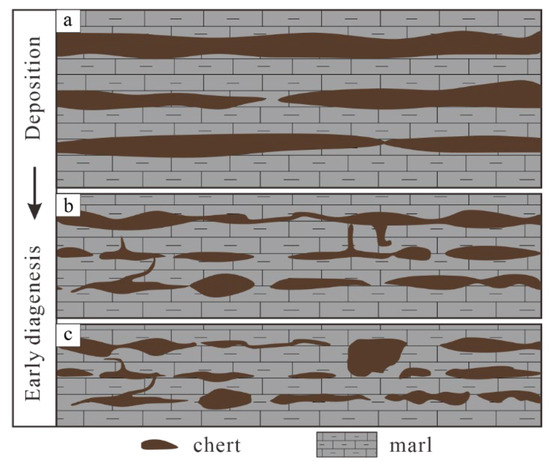
Figure 11.
The formation model of chert nodules in the Lucaogou Formation from the Junggar Basin, NW China. (a) Siliceous sedimentation mainly displayed as banded or quasi-banded in depositional stage; (b,c) in early diagenesis, cherts deformed into nodular or lenticular shape.
Given that the LCG cherts resulted from the silication of hydrothermal fluids, sedimentary intervals that contain chert nodules in LCG Fm. further confirm the occurrence of episodic high-temperature hydrothermal activity in the Bogda area. The well-distributed synsedimentary fault activities [42,48] indicate that these channels were responsible for transporting hydrothermal materials in the Bogda area (Figure 10). Importantly, the hydrothermal activities in the Bogda Rift closely correspond to the PCE [26], assuming an estimated age of about 269 Ma [53,58] of the LCG cherts. The LCG chert nodules and the hydrothermal fluids potentially record the response to the PCE [19,100], providing an important contribution to PCE studies in the SE Junggar Basin, NW China.
6. Conclusions
Chert nodules, occurring as 2 to 60 mm long spheroids, are mainly composed of crypto-microcrystalline silica in the Lucaogou Formation, SE Junggar Basin. Lacking recrystallization, their soft-sediment deformation structure indicates the synsedimentary sedimentation of chert deposits. Furthermore, the distribution of authigenic metal-bearing minerals (such as barite, jacobsite and azurite) and the elemental evidence, such as high Eu/Eu∗ ratios (average 2.14), low ∑REE content (average 6.03 ppm), low LaN/YbN ratios (average 0.17) and low Y/Ho ratios (average 25.25), suggest that the silicon source derives from hydrothermal fluids. As evidenced by the significant positive Eu anomaly in LCG chert nodules, these fluids resulted from episodic high-temperature (>250 °C) hydrothermal activities in the Bogda area. Temperature is assumed to be the main factor leading to the rapid precipitation of inchoate chert, whilst differential compaction is responsible for the varied morphologies of the nodules. Importantly, the hydrothermal activities recorded in LCG chert nodules in the Bogda area, Junggar Basin, appear to be a response to the PCE globally.
Author Contributions
Conceptualization, J.Z.; methodology, H.Y., H.L. and J.Z.; data curation, H.Y., H.L., Y.J. and J.Z.; writing—original draft preparation, J.Z.; writing—review and editing, J.Z. and H.Y.; visualization, J.Z.; supervision, J.Z.; project administration, J.Z.; funding acquisition, J.Z. All authors have read and agreed to the published version of the manuscript.
Funding
This research was funded by the National Science and Technology Major Project of China, grant number 2017ZX05008-001.
Acknowledgments
We thank the editors and anonymous reviewers who provided constructive and thoughtful comments that helped improve the manuscript.
Conflicts of Interest
The authors declare no conflict of interest.
References
- Adachi, M.; Yamamoto, K.; Sugisaki, R. Hydrothermal chert and associated siliceous rocks from the northern Pacific their geological significance as indication od ocean ridge activity. Sediment. Geol. 1986, 47, 125–148. [Google Scholar] [CrossRef]
- Murchey, B.L.; Jones, D.L. A mid-Permian chert event: Widespread deposition of biogenic siliceous sediments in coastal, island arc and oceanic basins. Palaeogeogr. Palaeoclimatol. Palaeoecol. 1992, 96, 161–174. [Google Scholar] [CrossRef]
- Murray, R.W. Chemical criteria to identify the depositional environment of chert: General principles and applications. Sediment. Geol. 1994, 90, 213–232. [Google Scholar] [CrossRef]
- Shen, B.; Ma, H.R.; Ye, H.Q.; Lang, X.G.; Pei, H.X.; Zhou, C.M.; Zhang, S.H.; Yang, R.Y. Hydrothermal origin of syndepositional chert bands and nodules in the Mesoproterozoic Wumishan Formation: Implications for the evolution of Mesoproterozoic cratonic basin, North China. Precambrian Res. 2018, 310, 213–228. [Google Scholar] [CrossRef]
- Tatzel, M.; von Blanckenburg, F.; Oelze, M.; Schuessler, J.A.; Bohrmann, G. The silicon isotope record of early silica diagenesis. Earth Planet. Sci. Lett. 2015, 428, 293–303. [Google Scholar] [CrossRef]
- Yamamoto, K. Geochemical Characteristics and Depositional-Environments of Cherts and Associated Rocks in the Franciscan and Shimanto Terranes. Sediment. Geol. 1987, 52, 65–108. [Google Scholar] [CrossRef]
- Treguer, P.; Nelson, D.M.; Vanbennekom, A.J.; Demaster, D.J.; Leynaert, A.; Queguiner, B. The Silica Balance in the World Ocean—A Reestimate. Science 1995, 268, 375–379. [Google Scholar] [CrossRef]
- Crerar, D.; Anderson, G.J.C.G. Solubility and solvation reactions of quartz in dilute hydrothermal solutions. Chem. Geol. 1971, 8, 107–122. [Google Scholar] [CrossRef]
- Kuma, R.; Hasegawa, H.; Yamamoto, K.; Yoshida, H.; Whiteside, J.H.; Katsuta, N.; Ikeda, M. Biogenically induced bedded chert formation in the alkaline palaeo-lake of the Green River formation. Sci. Rep. 2019, 9, 16448. [Google Scholar] [CrossRef]
- Wells, N.A. Carbonate deposition, physical limnology and environmentally controlled chert formation in Paleocene-Eocene Lake Flagstaff, central Utah. Sediment. Geol. 1983, 35, 263–296. [Google Scholar] [CrossRef]
- Guo, P.; Li, C.; Wen, H.; Wei, Y.; Lei, H. Genesis of Continental Siliceous Rocks and Their Tectonic-climatic Significance. Acta Sedimentol. Sin. 2022, 40, 450–464. [Google Scholar] [CrossRef]
- Dong, Y.X.; Xu, S.L.; Wen, L.; Chen, H.D.; Fu, S.Y.; Zhong, Y.J.; Wang, J.Y.; Zhu, P.; Cui, Y. Tectonic control of Guadalupian-Lopingian cherts in northwestern Sichuan Basin, South China. Palaeogeogr. Palaeoclimatol. Palaeoecol. 2020, 557, 109915. [Google Scholar] [CrossRef]
- Lampropoulou, P.; Xanthopoulou, V.; Wojtaszek-Kalaitzidi, M.; Petrounias, P.; Zoumpouli, E.; Iliopoulos, G.; Kalaitzidis, S. Characterization of Siliceous Nodules in Western Kefalonia Ιsland Greece: An Initial Approach to Their Formation and Diagenetic Characteristics. Minerals 2022, 12, 101. [Google Scholar] [CrossRef]
- Shen, B.; Lee, C.T.A.; Xiao, S.H. Germanium/silica ratios in diagenetic chert nodules from the Ediacaran Doushantuo Formation, South China. Chem. Geol. 2011, 280, 323–335. [Google Scholar] [CrossRef]
- Renaut, R.; Jones, B.; Tiercelin, J.J. Rapid in situ silicification of microbes at Loburu hot springs, Lake Bogoria, Kenya Rift Valley. Sedimentology 1998, 45, 1083–1103. [Google Scholar] [CrossRef]
- Yao, X.; Li, S.; Zhou, Y.Q.; Hinnov, L.A. Hydrothermal Origin of Early Permian Chert Nodules in the Central North China Craton Linked to Northern Margin Cratonic Activation. Acta Geol. Sin-Engl. 2021, 95, 541–557. [Google Scholar] [CrossRef]
- Peterson, M.; Von der Borch, C. Chert: Modern inorganic deposition in a carbonate-precipitating locality. Science 1965, 149, 1501–1503. [Google Scholar] [CrossRef]
- White, A.H.; Youngs, B.C. Cambrian Alkali Playa-Lacustrine Sequence in the Northeastern Officer Basin, South-Australia. J. Sediment Petrol. 1980, 50, 1279–1286. [Google Scholar] [CrossRef]
- Qiu, Z.; Wang, Q. Geochemical evidence for submarine hydrothermal origin of the Middle-Upper Permian chert in Laibin of Guangxi, China. Sci. China Earth Sci. 2011, 54, 1011–1023. [Google Scholar] [CrossRef]
- Kato, Y.; Nakao, K.; Isozaki, Y. Geochemistry of Late Permian to Early Triassic pelagic cherts from southwest Japan: Implications for an oceanic redox change. Chem. Geol. 2002, 182, 15–34. [Google Scholar] [CrossRef]
- Sengupta, S.; Pack, A. Triple Oxygen Isotope Values of Cherts as a Proxy for the δ 18 O and Temperature Evolution of Seawater. In Proceedings of the AGU Fall Meeting Abstracts, Washington, DC, USA, 10–14 December 2018; p. V31B-06. [Google Scholar]
- Gao, P.; He, Z.L.; Lash, G.G.; Li, S.J.; Xiao, X.M.; Han, Y.Q.; Zhang, R.Q. Mixed seawater and hydrothermal sources of nodular chert in Middle Permian limestone on the eastern Paleo-Tethys margin (South China). Palaeogeogr. Palaeoclimatol. Palaeoecol. 2020, 551, 109740. [Google Scholar] [CrossRef]
- Zheng, H.F.; Wu, J.F.; Tang, H.L.; Liu, B.; Yang, X.Y.; Shi, K.B.; Luo, K.P.; Qiu, Q.; Dong, Y.X. Origin of the Multiple-Sourced Cherts in Maokou Carbonates in Sichuan Basin, South China. Minerals 2021, 11, 1269. [Google Scholar] [CrossRef]
- Yao, X.; Zhou, Y.; Li, S.; Li, D. Research status and advances in chert and Permian chert event. Adv. Earth Sci. 2013, 28, 1189–1200. [Google Scholar]
- Kamata, Y.; Maezawa, A.; Hara, H.; Ueno, K.; Hisada, K.; Sardsud, A.; Charoentitirat, T.; Charusiri, P. Basaltic activity preserved in an Upper Permian radiolarian chert from the Paleo-Tethys in the Inthanon Zone, northern Thailand. J. Asian Earth Sci. 2012, 61, 51–61. [Google Scholar] [CrossRef]
- Beauchamp, B.; Baud, A. Growth and demise of Permian biogenic chert along northwest Pangea: Evidence for end-Permian collapse of thermohaline circulation. Palaeogeogr. Palaeoclimatol. Palaeoecol. 2002, 184, 37–63. [Google Scholar] [CrossRef]
- Bohrmann, G.; Abelmann, A.; Gersonde, R.; Hubberten, H.; Kuhn, G. Pure Siliceous Ooze, a Diagenetic Environment for Early Chert Formation. Geology 1994, 22, 207–210. [Google Scholar] [CrossRef]
- Yu, K.H.; Zhang, Z.J.; Cao, Y.C.; Qiu, L.W.; Zhou, C.N.; Cheng, D.W.; Sun, P.P.; Yang, Y.Q. Origin of biogenic-induced cherts from Permian alkaline saline lake deposits in the NW Junggar Basin, NW China: Implications for hydrocarbon exploration. J. Asian Earth Sci. 2021, 211, 104712. [Google Scholar] [CrossRef]
- Yang, Y. A Preliminary Study on Exhalative Hydrothermal Deposits in the Lucaogou Formation in Jimusar Sag, Junggar Basin. Ph.D. Thesis, Northwestern University, Washington, DC, USA, 2014. [Google Scholar]
- Gao, Y.; Wang, G.; Li, N. Geochemical features and origin of siliceous rocks of the Permian Fengcheng Formation in the northwestern margin of Junggar Basin. J. Palaeogeog. Chin. 2019, 21, 647–660. [Google Scholar] [CrossRef]
- Wei, Y.; Guo, P.; Jing, J.; Jiang, Y.; Wang, J.; Lei, H.; Wen, H. Silexite genesis in volcanic-alkali lacustrine sedimentaryrocks: A case study of the lower Permian Fengcheng Formation, Junggar basin. Miner. Petrol. 2021, 41, 83–98. [Google Scholar] [CrossRef]
- Pe-Piper, G.; Piper, D.J.; Bourli, N.; Zelilidis, A. Evolution of Sedimentary Basins as Recorded in Silica Concretions: An Example from the Ionian Zone, Western Greece. Minerals 2021, 11, 763. [Google Scholar] [CrossRef]
- Meng, Z.; Liu, Y.; Jiao, X.; Ma, L.; Zhou, D.; Li, H.; Cao, Q.; Zhao, M.; Yang, Y. Petrological and organic geochemical characteristics of the Permian Lucaogou Formation in the Jimsar Sag, Junggar Basin, NW China: Implications on the relationship between hydrocarbon accumulation and volcanic-hydrothermal activities. J. Pet. Sci. Eng. 2022, 210, 110078. [Google Scholar] [CrossRef]
- Tao, H.F.; Qiu, Z.; Qu, Y.Q.; Liu, J.; Qin, Z.; Xie, Z.B.; Qiu, J.L.; Liu, B. Geochemistry of Middle Permian lacustrine shales in the Jimusar Sag, Junggar Basin, NW China: Implications for hydrothermal activity and organic matter enrichment. J. Asian Earth Sci. 2022, 232, 105267. [Google Scholar] [CrossRef]
- Wei, W.; Azmy, K.; Zhu, X.M. Impact of diagenesis on reservoir quality of the lacustrine mixed carbonate-siliciclastic-volcaniclastic rocks in China. J. Asian Earth Sci. 2022, 233, 105265. [Google Scholar] [CrossRef]
- Jiang, Y.Q.; Liu, Y.Q.; Yang, Z.; Nan, Y.; Wang, R.; Zhou, P.; Yang, Y.J.; Kou, J.Y.; Zhou, N.C. Characteristics and origin of tuff-type tight oil in Jimusaer sag, Junggar Basin, NW China. Petrol. Explor. Dev. 2015, 42, 810–818. [Google Scholar] [CrossRef]
- Zhang, C.; Liu, D.D.; Jiang, Z.X.; Song, Y.; Luo, Q.; Wang, X. Mechanism for the formation of natural fractures and their effects on shale oil accumulation in Junggar Basin, NW China. Int. J. Coal Geol. 2022, 254, 103973. [Google Scholar] [CrossRef]
- Wang, J.; Wu, C.; Zhou, T.; Zhu, W.; Zhou, Y.; Jiang, X.; Yang, D. Source-to-sink analysis of a transtensional rift basin from syn-rift to uplift stages. J. Sediment Res. 2019, 89, 335–352. [Google Scholar] [CrossRef]
- Allen, M.; Sengor, A.; Natal’In, B. Junggar, Turfan and Alakol basins as Late Permian to? Early Triassic extensional structures in a sinistral shear zone in the Altaid orogenic collage, Central Asia. J. Geol. Soc. London 1995, 152, 327–338. [Google Scholar] [CrossRef]
- Obrist-Farner, J.; Yang, W. Provenance and depositional conditions of fluvial conglomerates and sandstones and their controlling processes in a rift setting, mid-Permian lower and upper Quanzijie low order cycles, Bogda Mountains, NW China. J. Asian Earth Sci. 2017, 138, 317–340. [Google Scholar] [CrossRef]
- Yang, W.; Feng, Q.A.; Liu, Y.Q.; Tabor, N.; Miggins, D.; Crowley, J.L.; Lin, J.Y.; Thomas, S. Depositional environments and cyclo- and chronostratigraphy of uppermost Carboniferous-Lower Triassic fluvial-lacustrine deposits, southern Bogda Mountains, NW China—A terrestrial paleoclimatic record of mid-latitude NE Pangea. Glob. Planet. Chang. 2010, 73, 15–113. [Google Scholar] [CrossRef]
- Yang, W.; Liu, Y.Q.; Feng, Q.; Lin, J.Y.; Zhou, D.W.; Wang, D. Sedimentary evidence of Early-Late Permian mid-latitude continental climate variability, southern Bogda Mountains, NW China. Palaeogeogr. Palaeoclimatol. Palaeoecol. 2007, 252, 239–258. [Google Scholar] [CrossRef]
- Greene, T.J.; Carroll, A.R.; Wartes, M.; Graham, S.A.; Wooden, J.L. Integrated provenance analysis of a complex orogenic terrane: Mesozoic uplift of the Bogda Shan and inception of the Turpan-Hami Basin, NW China. J. Sediment Res. 2005, 75, 251–267. [Google Scholar] [CrossRef]
- Jun, G.; Maosong, L.; Xuchang, X.; Yaoqing, T.; Guoqi, H. Paleozoic tectonic evolution of the Tianshan Orogen, northwestern China. Tectonophysics 1998, 287, 213–231. [Google Scholar] [CrossRef]
- Han, B.F.; Guo, Z.J.; Zhang, Z.C.; Zhang, L.; Chen, J.F.; Song, B. Age, geochemistry, and tectonic implications of a late Paleozoic stitching pluton in the North Tian Shan suture zone, western China. Geol. Soc. Am. Bull. 2010, 122, 627–640. [Google Scholar] [CrossRef]
- Xiao, W.J.; Windley, B.F.; Allen, M.B.; Han, C.M. Paleozoic multiple accretionary and collisional tectonics of the Chinese Tianshan orogenic collage. Gondwana Res. 2013, 23, 1316–1341. [Google Scholar] [CrossRef]
- Wang, J.; Wu, C.; Li, Z.; Zhu, W.; Zhou, T.; Wu, J.; Wang, J. The tectonic evolution of the Bogda region from Late Carboniferous to Triassic time: Evidence from detrital zircon U–Pb geochronology and sandstone petrography. Geol. Mag. 2018, 155, 1063–1088. [Google Scholar] [CrossRef]
- Scotese, C.; Schettino, A. Late Permian-Early Jurassic paleogeography of western Tethys and the world. In Permo-Triassic Salt Provinces of Europe, North Africa and the Atlantic Margins; Elsevier: Amsterdam, The Netherlands, 2017; pp. 57–95. [Google Scholar] [CrossRef]
- Choulet, F.; Faure, M.; Cluzel, D.; Chen, Y.; Lin, W.; Wang, B. From oblique accretion to transpression in the evolution of the Altaid collage: New insights from West Junggar, northwestern China. Gondwana Res. 2012, 21, 530–547. [Google Scholar] [CrossRef]
- Buckman, S.; Aitchison, J.C. Tectonic evolution of Palaeozoic terranes in West Junggar, Xinjiang, NW China. Asp. Tecton. Evol. China 2004, 226, 101–129. [Google Scholar] [CrossRef]
- Liu, J.; Yi, J.; Chen, J.Y. Constraining assembly time of some blocks on eastern margin of Pangea using Permo-Triassic non-marine tetrapod records. Earth-Sci. Rev. 2020, 207, 103215. [Google Scholar] [CrossRef]
- Zhao, R.; Zhang, J.Y.; Zhou, C.M.; Zhang, Z.J.; Chen, S.; Stockli, D.F.; Olariu, C.; Steel, R.; Wang, H. Tectonic evolution of Tianshan-Bogda-Kelameili mountains, clastic wedge basin infill and chronostratigraphic divisions in the source-to-sink systems of Permian-Jurassic, southern Junggar Basin. Mar. Petrol. Geol. 2020, 114, 104200. [Google Scholar] [CrossRef]
- Gao, Y.; Huang, H.; Tao, H.F.; Carroll, A.R.; Qin, J.M.; Chen, J.Q.; Yuan, X.G.; Wang, C.S. Paleoenvironmental setting, mechanism and consequence of massive organic carbon burial in the Permian Junggar Basin, NW China. J. Asian Earth Sci. 2020, 194, 104222. [Google Scholar] [CrossRef]
- Ding, X.; Gao, C.; Zha, M.; Chen, H.; Su, Y. Depositional environment and factors controlling β-carotane accumulation: A case study from the Jimsar Sag, Junggar Basin, northwestern China. Palaeogeogr. Palaeoclimatol. Palaeoecol. 2017, 485, 833–842. [Google Scholar] [CrossRef]
- Wang, Y.; Chen, S.; Zhang, G.; Zhang, K.; Lin, H.; Liang, H.; Wang, Y.; Li, J. Classifications of mixosedimentite and sedimentary facies characteristics of mixed sedimentary facies belt in saline lacustrine basin: Taking examples as the Lucaogou Formation in the south of Junggar Basin and the Taerlang Formation in the northwest of Tuha Basin. Acta Petrolei. Sinica 2017, 38, 1021–1035,1065. [Google Scholar] [CrossRef]
- Carroll, A.R.; Graham, S.A.; Hendrix, M.S.; Ying, D.; Zhou, D. Late Paleozoic Tectonic Amalgamation of Northwestern China—Sedimentary Record of the Northern Tarim, Northwestern Turpan, and Southern Junggar Basins. Geol. Soc. Am. Bull. 1995, 107, 571–594. [Google Scholar] [CrossRef]
- Graham, S. Sedimentary record of Mesozoic deformation and inception of the Turpan-Hami basin, northwest China. Paleoz. Mesoz. Tecton. Evol. Cent. East. Asia 2001, 194, 317. [Google Scholar] [CrossRef]
- Huang, H.; Gao, Y.; Jones, M.M.; Tao, H.F.; Carroll, A.R.; Ibarra, D.E.; Wu, H.C.; Wang, C.S. Astronomical forcing of Middle Permian terrestrial climate recorded in a large paleolake in northwestern China. Palaeogeogr. Palaeoclimatol. Palaeoecol. 2020, 550, 109735. [Google Scholar] [CrossRef]
- Yang, Z.; He, S.; Li, Q.Y.; Lin, S.H.; Pan, S.Q. Geochemistry characteristics and significance of two petroleum systems near top overpressured surface in central Junggar Basin, NW China. Mar. Petrol. Geol. 2016, 75, 341–355. [Google Scholar] [CrossRef]
- Zhi, Y.; Zou, C.N.; Wu, S.T.; Lin, S.H.; Pan, S.Q.; Niu, X.B.; Men, G.T.; Tang, Z.X.; Li, G.H.; Zhao, J.H.; et al. Formation, distribution and resource potential of the “sweet areas (sections)” of continental shale oil in China. Mar. Petrol. Geol. 2019, 102, 48–60. [Google Scholar] [CrossRef]
- Yang, Y.; Qiu, L.; Wan, M.; Jia, X.; Cao, Y.; Lei, D.; Qu, C.S. Depositional model for a salinized lacustrine basin: The permian Lucaogou formation, Jimsar sag, Junggar Basin, NW China. J. Asian Earth Sci. 2019, 178, 81–95. [Google Scholar] [CrossRef]
- Cao, Z.; Liu, G.D.; Xiang, B.L.; Wang, P.; Niu, G.; Niu, Z.C.; Li, C.Z.; Wang, C.Y. Geochemical characteristics of crude oil from a tight oil reservoir in the Lucaogou Formation, Jimusar sag, Junggar Basin. Aapg Bull. 2017, 101, 39–72. [Google Scholar] [CrossRef]
- Cao, Z.; Liu, G.D.; Zhan, H.B.; Gao, J.; Zhang, J.Y.; Li, C.Z.; Xiang, B.L. Geological roles of the siltstones in tight oil play. Mar. Petrol. Geol. 2017, 83, 333–344. [Google Scholar] [CrossRef]
- Sun, F.N.; Hu, W.X.; Wang, X.L.; Cao, J.; Fu, B.; Wu, H.G.; Yang, S.C. Methanogen microfossils and methanogenesis in Permian lake deposits. Geology 2021, 49, 13–18. [Google Scholar] [CrossRef]
- Sun, F.N.; Hu, W.X.; Cao, J.; Wang, X.L.; Zhang, Z.R.; Ramezani, J.; Shen, S.Z. Sustained and intensified lacustrine methane cycling during Early Permian climate warming. Nat. Commun. 2022, 13, 4856. [Google Scholar] [CrossRef] [PubMed]
- Jin, J.; Wang, J.; Meng, Y.; Sun, P.C.; Liu, Z.J.; Li, Y.J.; Fang, S. Main Controlling Factors and Development Model of the Oil Shale Deposits in the Late Permian Lucaogou Formation, Junggar Basin (NW China). Acs. Earth Space Chem. 2022, 6, 1080–1094. [Google Scholar] [CrossRef]
- Liu, D.; Fan, Q.; Zhang, C.; Gao, Y.; Du, W.; Song, Y.; Zhang, Z.; Luo, Q.; Jiang, Z.; Huang, Z. Paleoenvironment evolution of the Permian Lucaogou Formation in the southern Junggar Basin, NW China. Palaeogeogr. Palaeoclimatol. Palaeoecol. 2022, 603, 111198. [Google Scholar] [CrossRef]
- Yang, Y.; Liu, Y.; Jiang, Y.; Yang, Z.; Zhou, D.; Jiao, X.; Zhou, P.; Li, X.; Jin, M. Geochemistry of the dolomitic rocks from the Permian Lucaogou Formation in the Jimusar depression, Junggar Basin, Xinjiang. Sediment. Geol. Tethyan Geol. 2019, 39, 84–93. [Google Scholar] [CrossRef]
- Liu, Y.; Zhou, D.; Jiao, X.; Feng, Q.; Zhou, X. A preliminary study on the relationship between deep-sourced materials and hydrocarbon generation in lacustrine source rocks: An example from the Permian black rock series in Jimusar sag, Junggar Basin. J. Palaeogeog. Chin. 2019, 21, 983–998. [Google Scholar] [CrossRef]
- Li, Z.; Liu, Y.; Jiao, X.; Zhou, D. Deep-derived clastics with porphyroclastic structure in lacustrine fine-grained sediments: Case study of the Permian Lucaogou Formation in Jimsar Sag, Junggar Basin. Nat. Gas Geosci. 2020, 31, 220–234. [Google Scholar] [CrossRef]
- Ma, J.; Wu, C.D.; Wang, Y.Z.; Wang, J.L.; Fang, Y.N.; Zhu, W.; Zhai, L.N.; Zhou, T.Q. Paleoenvironmental reconstruction of a saline lake in the Tertiary: Evidence from aragonite laminae in the northern Tibet Plateau. Sediment. Geol. 2017, 353, 1–12. [Google Scholar] [CrossRef]
- Larson, A.C.; Von Dreele, R.B. General Structure Analysis System (GSAS). Los Alamos National Laboratory Report LAUR 1994, 86–748. [Google Scholar]
- Mills, R.A.; Elderfield, H. Rare earth element geochemistry of hydrothermal deposits from the active TAG Mound, 26 N Mid-Atlantic Ridge. Geochim. Cosmochim. Acta 1995, 59, 3511–3524. [Google Scholar] [CrossRef]
- Alibo, D.S.; Nozaki, Y. Rare earth elements in seawater: Particle association, shale-normalization, and Ce oxidation. Geochim. Cosmochim. Acta 1999, 63, 363–372. [Google Scholar] [CrossRef]
- Krainer, K.; Spötl, C. Abiogenic silica layers within a fluvio-lacustrine succession, Bolzano Volcanic Complex, northern Italy: A Permian analogue for Magadi-type cherts? Sedimentology 1998, 45, 489–505. [Google Scholar] [CrossRef]
- Parnell, J. Devonian Magadi-Type Cherts in the Orcadian Basin, Scotland. J. Sediment Petrol. 1986, 56, 495–500. [Google Scholar] [CrossRef]
- Hedenquist, J.W.; Lowenstern, J.B. The Role of Magmas in the Formation of Hydrothermal Ore-Deposits. Nature 1994, 370, 519–527. [Google Scholar] [CrossRef]
- Paytan, A.; Mearon, S.; Cobb, K.; Kastner, M. Origin of marine barite deposits: Sr and S isotope characterization. Geology 2002, 30, 747–750. [Google Scholar] [CrossRef]
- Peters, T. Geochemistry of manganese-bearing cherts associated with Alpine ophiolites and the Hawasina formations in Oman. Mar. Geol. 1988, 84, 229–238. [Google Scholar] [CrossRef]
- Zabel, M.; Bickert, T.; Dittert, L. Significance of the sedimentary Al: Ti ratio as an indicator for variations in the circulation patterns of the equatorial North Atlantic. Paleoceanography 1999, 14, 789–799. [Google Scholar] [CrossRef]
- Zabel, M.; Schneider, R.R.; Wagner, T.; Adegbie, A.T.; de Vries, U.; Kolonic, S. Late Quaternary climate changes in central Africa as inferred from terrigenous input to the Niger fan. Quaternary Res. 2001, 56, 207–217. [Google Scholar] [CrossRef]
- Xing, C.C.; Liu, P.J.; Wang, R.M.; Li, C.Q.; Li, J.H.; Shen, B. Tracing the evolution of dissolved organic carbon (DOC) pool in the Ediacaran ocean by Germanium/silica (Ge/Si) ratios of diagenetic chert nodules from the Doushantuo Formation, South China. Precambrian Res. 2022, 374, 106639. [Google Scholar] [CrossRef]
- Cui, Y.X.; Lang, X.G.; Li, F.B.; Huang, K.J.; Ma, H.R.; Li, C.Q.; Pei, H.X.; Li, C.; Zhou, C.M.; Shen, B. Germanium/silica ratio and rare earth element composition of silica-filling in sheet cracks of the Doushantuo cap carbonates, South China: Constraining hydrothermal activity during the Marinoan snowball Earth glaciation. Precambrian Res. 2019, 332, 105407. [Google Scholar] [CrossRef]
- Thomas, R. Practical Guide to ICP-MS: A Tutorial for Beginners; CRC Press: Boca Raton, FL, USA, 2008. [Google Scholar]
- Smirnova, E.; Mysovskaya, I.; Lozhkin, V.; Sandimirova, G.; Pakhomova, N.; Smagunova, A. Spectral interferences from polyatomic barium ions in inductively coupled plasma mass spectrometry. J. Appl. Spectrosc. 2006, 73, 911–917. [Google Scholar] [CrossRef]
- Bolhar, R.; Van Kranendonk, M.J. A non-marine depositional setting for the northern Fortescue Group, Pilbara Craton, inferred from trace element geochemistry of stromatolitic carbonates. Precambrian Res. 2007, 155, 229–250. [Google Scholar] [CrossRef]
- Bau, M. Controls on the fractionation of isovalent trace elements in magmatic and aqueous systems: Evidence from Y/Ho, Zr/Hf, and lanthanide tetrad effect. Contrib. Miner. Petrol. 1996, 123, 323–333. [Google Scholar] [CrossRef]
- Tréguer, P.J.; De La Rocha, C.L. The world ocean silica cycle. Annu. Rev. Mar. Sci. 2013, 5, 477–501. [Google Scholar] [CrossRef] [PubMed]
- Urabe, T.; Kusakabe, M. Barite Silica Chimneys from the Sumisu Rift, Izu-Bonin Arc—Possible Analog to Hematitic Chert Associated with Kuroko Deposits. Earth Planet. Sci. Lett. 1990, 100, 283–290. [Google Scholar] [CrossRef]
- Bau, M.; Dulski, P. Comparing yttrium and rare earths in hydrothermal fluids from the Mid-Atlantic Ridge: Implications for Y and REE behaviour during near-vent mixing and for the Y/Ho ratio of Proterozoic seawater. Chem. Geol. 1999, 155, 77–90. [Google Scholar] [CrossRef]
- Gao, P.; He, Z.L.; Lash, G.G.; Li, S.J.; Zhang, R.Q. Origin of chert nodules in the Ediacaran Doushantuo Formation black shales from Yangtze Block, South China. Mar. Petrol. Geol. 2020, 114, 104227. [Google Scholar] [CrossRef]
- Murray, R.W.; Ten Brink, M.R.B.; Gerlach, D.C.; Russ, G.P., III; Jones, D.L. Rare earth, major, and trace elements in chert from the Franciscan Complex and Monterey Group, California: Assessing REE sources to fine-grained marine sediments. Geochim. Cosmochim. Acta 1991, 55, 1875–1895. [Google Scholar] [CrossRef]
- Bolhar, R.; Van Kranendonk, M.J.; Kamber, B.S. A trace element study of siderite-jasper banded iron formation in the 3.45 Ga Warrawoona Group, Pilbara Craton—Formation from hydrothermal fluids and shallow seawater. Precambrian Res. 2005, 137, 93–114. [Google Scholar] [CrossRef]
- Xu, J.; Shen, S.; Wang, Y.; Wang, F. New Evidence of Middle Permian Hydrothermal Cherts Deposition: A case study of Jitingling Breccia, south Anhui province. Acta Sedimentol. Sin. 2020, 38, 284–296. [Google Scholar] [CrossRef]
- Nozaki, Y.; Zhang, J.; Amakawa, H. The fractionation between Y and Ho in the marine environment. Earth Planet. Sci. Lett. 1997, 148, 329–340. [Google Scholar] [CrossRef]
- Douville, E.; Bienvenu, P.; Charlou, J.L.; Donval, J.P.; Fouquet, Y.; Appriou, P.; Gamo, T. Yttrium and rare earth elements in fluids from various deep-sea hydrothermal systems. Geochim. Cosmochim. Acta 1999, 63, 627–643. [Google Scholar] [CrossRef]
- Chen, D.Z.; Qing, H.R.; Yan, X.; Li, H. Hydrothermal venting and basin evolution (Devonian, South China): Constraints from rare earth element geochemistry of chert. Sediment. Geol. 2006, 183, 203–216. [Google Scholar] [CrossRef]
- Bau, M. Rare-Earth Element Mobility during Hydrothermal and Metamorphic Fluid Rock Interaction and the Significance of the Oxidation-State of Europium. Chem. Geol. 1991, 93, 219–230. [Google Scholar] [CrossRef]
- Rimstidt, J. Geothermal Mineralization I: The Mechanism of Formation of the Beowawe, Nevada Siliceous Sinter Deposit. Ph.D. Thesis, University of Utah, Salt Lake City, UT, USA, 1982. [Google Scholar] [CrossRef]
- Cai, Z.X.; Li, J.; Chen, H.R.; Cong, F.Y.; Wu, N.; Wang, L.J.; Wei, Q.C.; Luo, Y.P. Genesis of Mg-phyllosilicate occurrences in the Middle Permian marine successions of South China. Appl. Clay Sci. 2019, 181, 105242. [Google Scholar] [CrossRef]
Publisher’s Note: MDPI stays neutral with regard to jurisdictional claims in published maps and institutional affiliations. |
© 2022 by the authors. Licensee MDPI, Basel, Switzerland. This article is an open access article distributed under the terms and conditions of the Creative Commons Attribution (CC BY) license (https://creativecommons.org/licenses/by/4.0/).